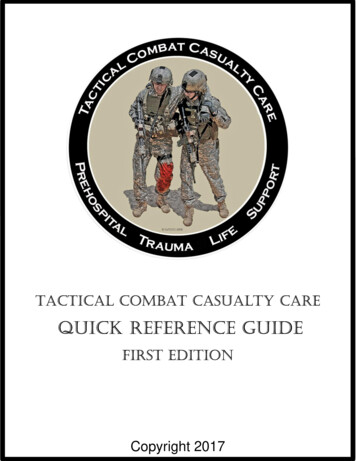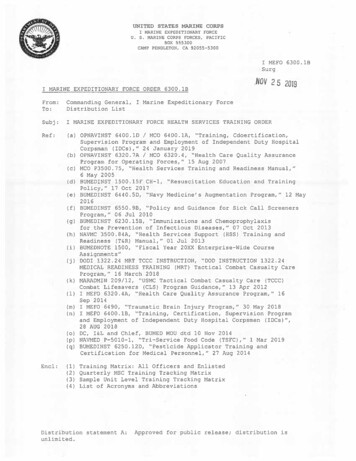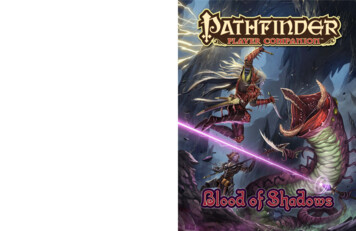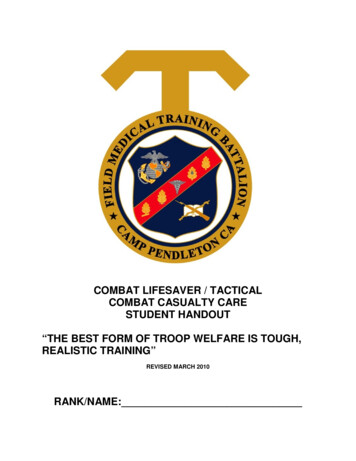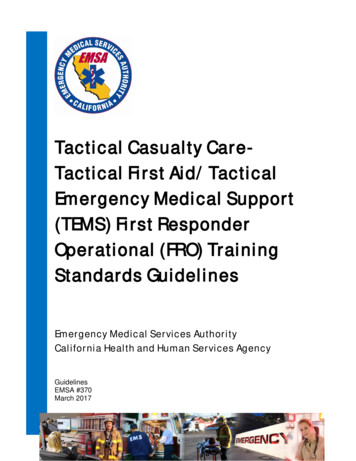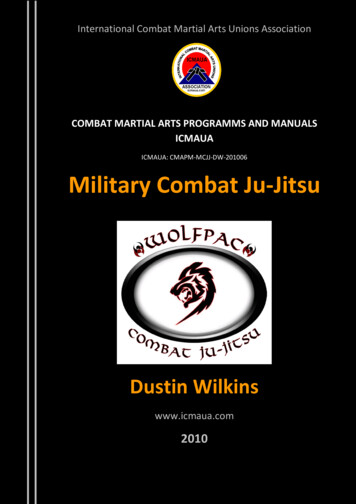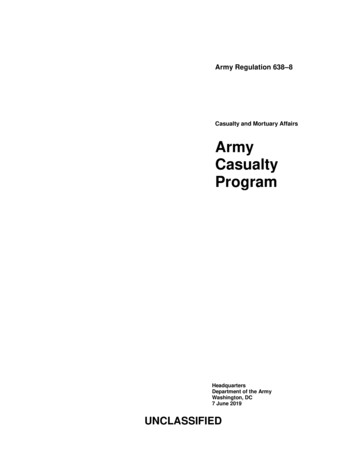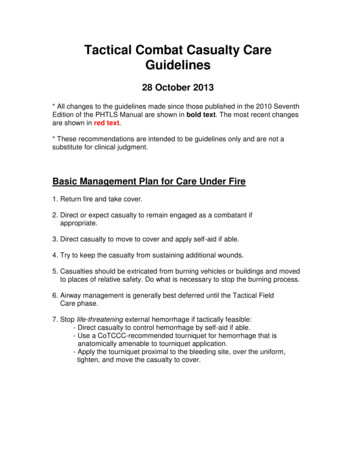
Transcription
Tactical Combat Casualty CareGuidelines28 October 2013* All changes to the guidelines made since those published in the 2010 SeventhEdition of the PHTLS Manual are shown in bold text. The most recent changesare shown in red text.* These recommendations are intended to be guidelines only and are not asubstitute for clinical judgment.Basic Management Plan for Care Under Fire1. Return fire and take cover.2. Direct or expect casualty to remain engaged as a combatant ifappropriate.3. Direct casualty to move to cover and apply self-aid if able.4. Try to keep the casualty from sustaining additional wounds.5. Casualties should be extricated from burning vehicles or buildings and movedto places of relative safety. Do what is necessary to stop the burning process.6. Airway management is generally best deferred until the Tactical FieldCare phase.7. Stop life-threatening external hemorrhage if tactically feasible:- Direct casualty to control hemorrhage by self-aid if able.- Use a CoTCCC-recommended tourniquet for hemorrhage that isanatomically amenable to tourniquet application.- Apply the tourniquet proximal to the bleeding site, over the uniform,tighten, and move the casualty to cover.
Basic Management Plan for Tactical Field Care1. Casualties with an altered mental status should be disarmedimmediately.2. Airway Managementa. Unconscious casualty without airway obstruction:- Chin lift or jaw thrust maneuver- Nasopharyngeal airway- Place casualty in the recovery positionb. Casualty with airway obstruction or impending airway obstruction:- Chin lift or jaw thrust maneuver- Nasopharyngeal airway- Allow casualty to assume any position that best protects theairway, to include sitting up.- Place unconscious casualty in the recovery position.- If previous measures unsuccessful:- Surgical cricothyroidotomy (with lidocaine ifconscious)3. Breathinga. In a casualty with progressive respiratory distress andknown or suspected torso trauma, consider a tensionpneumothorax and decompress the chest on the side of the injurywith a 14-gauge, 3.25 inch needle/catheter unit inserted in thesecond intercostal space at the midclavicular line. Ensure that theneedle entry into the chest is not medial to the nipple line and isnot directed towards the heart. An acceptable alternate site is the4th or 5th intercostal space at the anterior axillary line (AAL).b. All open and/or sucking chest wounds should be treated byimmediately applying a vented chest seal to cover the defect. If avented chest seal is not available, use a non-vented chest seal.Monitor the casualty for the potential development of a subsequenttension pneumothorax. If the casualty develops increasing hypoxia,respiratory distress, or hypotension and a tension pneumothoraxis suspected, treat by burping or removing the dressing or byneedle decompression.c. Casualties with moderate/severe TBI should be givensupplemental oxygen when available to maintain an oxygensaturation 90%.4. Bleeding2
a. Assess for unrecognized hemorrhage and control all sources ofbleeding. If not already done, use a CoTCCC-recommended tourniquetto control life-threatening external hemorrhage that is anatomicallyamenable to tourniquet application or for any traumatic amputation.Apply directly to the skin 2-3 inches above wound.b. For compressible hemorrhage not amenable to tourniquet use oras an adjunct to tourniquet removal (if evacuation time isanticipated to be longer than two hours), use Combat Gauze asthe hemostatic agent of choice. Combat Gauze should be appliedwith at least 3 minutes of direct pressure. Before releasing anytourniquet on a casualty who has been resuscitated forhemorrhagic shock, ensure a positive response to resuscitationefforts (i.e., a peripheral pulse normal in character and normalmentation if there is no traumatic brain injury (TBI). If the bleeding siteis appropriate for use of a junctional tourniquet, immediately applya CoTCCC-recommended junctional tourniquet. Do not delay inthe application of the junctional tourniquet once it is ready for use.Combat Gauze applied with direct pressure should be used if ajunctional tourniquet is not available or while the junctionaltourniquet is being readied for use.c. Reassess prior tourniquet application. Expose wound and determine iftourniquet is needed. If so, move tourniquet from over uniform andapply directly to skin 2-3 inches above wound. If a tourniquet is notneeded, use other techniques to control bleeding.d. When time and the tactical situation permit, a distal pulse checkshould be accomplished. If a distal pulse is still present, consideradditional tightening of the tourniquet or the use of a secondtourniquet, side by side and proximal to the first, to eliminate thedistal pulse.e. Expose and clearly mark all tourniquet sites with the time oftourniquet application. Use an indelible marker.5. Intravenous (IV) access- Start an 18-gauge IV or saline lock if indicated.- If resuscitation is required and IV access is not obtainable, use theintraosseous (IO) route.6. Tranexamic Acid (TXA)If a casualty is anticipated to need significant blood transfusion (forexample: presents with hemorrhagic shock, one or more majoramputations, penetrating torso trauma, or evidence of severe bleeding)– Administer 1 gram of tranexamic acid in 100 cc Normal Salineor Lactated Ringers as soon as possible but NOT later than 3hours after injury.– Begin second infusion of 1 gm TXA after Hextend or other fluidtreatment.3
7. Fluid resuscitationAssess for hemorrhagic shock; altered mental status (in the absenceof head injury) and weak or absent peripheral pulses are the best fieldindicators of shock.a. If not in shock:- No IV fluids necessary- PO fluids permissible if conscious and can swallowb. If in shock:- Hextend, 500-mL IV bolus- Repeat once after 30 minutes if still in shock.- No more than 1000 mL of Hextendc. Continued efforts to resuscitate must be weighed againstlogistical and tactical considerations and the risk of incurringfurther casualties.d. If a casualty with an altered mental status due to suspected TBIhas a weak or absent peripheral pulse, resuscitate as necessary tomaintain a palpable radial pulse.8. Prevention of hypothermiaa. Minimize casualty’s exposure to the elements. Keep protectivegear on or with the casualty if feasible.b. Replace wet clothing with dry if possible. Get the casualty onto aninsulated surface as soon as possible.c. Apply the Ready-Heat Blanket from the Hypothermia Preventionand Management Kit (HPMK) to the casualty’s torso (not directlyon the skin) and cover the casualty with the Heat-Reflective Shell(HRS).d. If an HRS is not available, the previously recommendedcombination of the Blizzard Survival Blanket and the Ready Heatblanket may also be used.e. If the items mentioned above are not available, use dry blankets,poncho liners, sleeping bags, or anything that will retain heat and keepthe casualty dry.f. Warm fluids are preferred if IV fluids are required.9. Penetrating Eye TraumaIf a penetrating eye injury is noted or suspected:a) Perform a rapid field test of visual acuity.b) Cover the eye with a rigid eye shield (NOT a pressure patch.)c) Ensure that the 400 mg moxifloxacin tablet in the combat pill packis taken if possible and that IV/IM antibiotics are given as outlinedbelow if oral moxifloxacin cannot be taken.10. MonitoringPulse oximetry should be available as an adjunct to clinical monitoring. All4
individuals with moderate/severe TBI should be monitored with pulseoximetry. Readings may be misleading in the settings of shock or markedhypothermia.11. Inspect and dress known wounds.12. Check for additional wounds.13. Analgesia on the battlefield should generally be achieved using one ofthree options:Option 1Mild to Moderate PainCasualty is still able to fight- TCCC Combat pill pack:- Tylenol - 650-mg bilayer caplet, 2 PO every 8 hours- Meloxicam - 15 mg PO once a dayOption 2Moderate to Severe PainCasualty IS NOT in shock or respiratory distress ANDCasualty IS NOT at significant risk of developing either condition- Oral transmucosal fentanyl citrate (OTFC) 800 ug- Place lozenge between the cheek and the gum- Do not chew the lozengeOption 3Moderate to Severe PainCasualty IS in hemorrhagic shock or respiratory distress ORCasualty IS at significant risk of developing either condition- Ketamine 50 mg IM or INOr- Ketamine 20 mg slow IV or IO* Repeat doses q30min prn for IM or IN* Repeat doses q20min prn for IV or IO* End points: Control of pain or development of nystagmus(rhythmic back-and-forth movement of the eyes)* Analgesia notesa. Casualties may need to be disarmed after being given OTFC orketamine.b. Document a mental status exam using the AVPU method prior toadministering opioids or ketamine.c. For all casualties given opiods or ketamine – monitor airway,breathing, and circulation closelyd. Directions for administering OTFC:5
- Recommend taping lozenge-on-a-stick to casualty’s finger asan added safety measure OR utilizing a safety pin andrubber band to attach the lozenge (under tension) to thecasualty’s uniform or plate carrier.- Reassess in 15 minutes- Add second lozenge, in other cheek, as necessaryto control severe pain- Monitor for respiratory depressione. IV Morphine is an alternative to OTFC if IV access has beenobtained- 5 mg IV/IO- Reassess in 10 minutes.- Repeat dose every 10 minutes as necessary to controlsevere pain.- Monitor for respiratory depressionf. Naloxone (0.4 mg IV or IM) should be available when using opioidanalgesics.g. Both ketamine and OTFC have the potential to worsen severe TBI.The combat medic, corpsman, or PJ must consider this fact in hisor her analgesic decision, but if the casualty is able to complainof pain, then the TBI is likely not severe enough to preclude theuse of ketamine or OTFC.h. Eye injury does not preclude the use of ketamine. The risk ofadditional damage to the eye from using ketamine is low andmaximizing the casualty’s chance for survival takes precedence ifthe casualty is in shock or respiratory distress or at significantrisk for either.i. Ketamine may be a useful adjunct to reduce the amount of opioidsrequired to provide effective pain relief. It is safe to give ketamineto a casualty who has previously received morphine or OTFC. IVKetamine should be given over 1 minute.j. If respirations are noted to be reduced after using opioids orketamine, provide ventilatory support with a bag-valve-mask ormouth-to-mask ventilations.k. Promethazine, 25 mg IV/IM/IO every 6 hours may be given asneeded for nausea or vomiting.l. Reassess – reassess – reassess!14. Splint fractures and recheck pulse.15. Antibiotics: recommended for all open combat woundsa. If able to take PO:- Moxifloxacin, 400 mg PO one a dayb. If unable to take PO (shock, unconsciousness):- Cefotetan, 2 g IV (slow push over 3-5 minutes) or IM every12 hours6
or- Ertapenem, 1 g IV/IM once a day16. Burnsa. Facial burns, especially those that occur in closed spaces, may beassociated with inhalation injury. Aggressively monitor airway statusand oxygen saturation in such patients and consider early surgicalairway for respiratory distress or oxygen desaturation.b. Estimate total body surface area (TBSA) burned to the nearest 10%using the Rule of Nines.c. Cover the burn area with dry, sterile dressings. For extensive burns( 20%), consider placing the casualty in the Heat-Reflective Shellor Blizzard Survival Blanket from the Hypothermia Prevention Kit inorder to both cover the burned areas and prevent hypothermia.d. Fluid resuscitation (USAISR Rule of Ten)– If burns are greater than 20% of Total Body Surface Area, fluidresuscitation should be initiated as soon as IV/IO access isestablished. Resuscitation should be initiated with LactatedRinger’s, normal saline, or Hextend. If Hextend is used, no morethan 1000 ml should be given, followed by Lactated Ringer’s ornormal saline as needed.– Initial IV/IO fluid rate is calculated as %TBSA x 10cc/hr for adultsweighing 40- 80 kg.– For every 10 kg ABOVE 80 kg, increase initial rate by 100 ml/hr.– If hemorrhagic shock is also present, resuscitation for hemorrhagicshock takes precedence over resuscitation for burn shock.Administer IV/IO fluids per the TCCC Guidelines in Section 6.e. Analgesia in accordance with the TCCC Guidelines in Section 12 maybe administered to treat burn pain.f. Prehospital antibiotic therapy is not indicated solely for burns, butantibiotics should be given per the TCCC guidelines in Section 14 ifindicated to prevent infection in penetrating wounds.g. All TCCC interventions can be performed on or through burned skin ina burn casualty.17. Communicate with the casualty if possible.- Encourage; reassure- Explain care18. Cardiopulmonary resuscitation (CPR)Resuscitation on the battlefield for victims of blast or penetratingtrauma who have no pulse, no ventilations, and no other signs of lifewill not be successful and should not be attempted. However, casualtieswith torso trauma or polytrauma who have no pulse or respirationsduring TFC should have bilateral needle decompression performed toensure they do not have a tension pneumothorax prior to7
discontinuation of care. The procedure is the same as described insection 3 above.19. Documentation of CareDocument clinical assessments, treatments rendered, and changes in thecasualty’s status on a TCCC Casualty Card (DD Form XXXX). Forward thisinformation with the casualty to the next level of care.8
Basic Management Plan for Tactical Evacuation Care* The term “Tactical Evacuation” includes both Casualty Evacuation (CASEVAC)and Medical Evacuation (MEDEVAC) as defined in Joint Publication 4-02.1. Airway Managementa. Unconscious casualty without airway obstruction:- Chin lift or jaw thrust maneuver- Nasopharyngeal airway- Place casualty in the recovery positionb. Casualty with airway obstruction or impending airway obstruction:- Chin lift or jaw thrust maneuver- Nasopharyngeal airway- Allow casualty to assume any position that bestprotects the airway, to include sitting up.- Place unconscious casualty in the recovery position.- If above measures unsuccessful:- Supraglottic airway or- Endotracheal intubation or- Surgical cricothyroidotomy (with lidocaine ifconscious).c. Spinal immobilization is not necessary for casualties withpenetrating trauma.2. Breathinga. In a casualty with progressive respiratory distress andknown or suspected torso trauma, consider a tensionpneumothorax and decompress the chest on the side of the injurywith a 14-gauge, 3.25 inch needle/catheter unit inserted in thesecond intercostal space at the midclavicular line. Ensure that theneedle entry into the chest is not medial to the nipple line and isnot directed towards the heart. An acceptable alternate site is the4th or 5th intercostal space at the anterior axillary line (AAL).b. Consider chest tube insertion if no improvement and/or longtransport is anticipated.c. Most combat casualties do not require supplemental oxygen, butadministration of oxygen may be of benefit for the following typesof casualties:- Low oxygen saturation by pulse oximetry- Injuries associated with impaired oxygenation- Unconscious casualty- Casualty with TBI (maintain oxygen saturation 90%)- Casualty in shock- Casualty at altitude9
d. All open and/or sucking chest wounds should be treated byimmediately applying a vented chest seal to cover the defect. If avented chest seal is not available, use a non-vented chest seal.Monitor the casualty for the potential development of a subsequenttension pneumothorax. If the casualty develops increasing hypoxia,respiratory distress, or hypotension and a tension pneumothoraxis suspected, treat by burping or removing the dressing or byneedle decompression.3. Bleedinga. Assess for unrecognized hemorrhage and control all sources ofbleeding. If not already done, use a CoTCCC-recommended tourniquetto control life-threatening external hemorrhage that is anatomicallyamenable to tourniquet application or for any traumatic amputation.Apply directly to the skin 2-3 inches above wound.b. For compressible hemorrhage not amenable to tourniquet use oras an adjunct to tourniquet removal (if evacuation time isanticipated to be longer than two hours), use Combat Gauze asthe hemostatic agent of choice. Combat Gauze should be appliedwith at least 3 minutes of direct pressure. Before releasing anytourniquet on a casualty who has been resuscitated forhemorrhagic shock, ensure a positive response to resuscitationefforts (i.e., a peripheral pulse normal in character and normalmentation if there is no TBI.) If the bleeding site is appropriate foruse of a junctional tourniquet, immediately apply a CoTCCCrecommended junctional tourniquet. Do not delay in theapplication of the junctional tourniquet once it is ready for use.Combat Gauze applied with direct pressure should be used if ajunctional tourniquet is not available or while the junctionaltourniquet is being readied for use.c. Reassess prior tourniquet application. Expose wound and determine iftourniquet is needed. If so, move tourniquet from over uniform andapply directly to skin 2-3 inches above wound. If a tourniquet is notneeded, use other techniques to control bleeding.d. When time and the tactical situation permit, a distal pulse checkshould be accomplished. If a distal pulse is still present, consideradditional tightening of the tourniquet or the use of a secondtourniquet, side by side and proximal to the first, to eliminate thedistal pulse.e. Expose and clearly mark all tourniquet sites with the time oftourniquet application. Use an indelible marker.4. Intravenous (IV) accessa. Reassess need for IV access.10
- If indicated, start an 18-gauge IV or saline lock- If resuscitation is required and IV access is not obtainable,use intraosseous (IO) route.5. Tranexamic Acid (TXA)If a casualty is anticipated to need significant blood transfusion (forexample: presents with hemorrhagic shock, one or more majoramputations, penetrating torso trauma, or evidence of severe bleeding)– Administer 1 gram of tranexamic acid in 100 cc Normal Salineor Lactated Ringers as soon as possible but NOT later than 3hours after injury.– Begin second infusion of 1 gm TXA after Hextend or other fluidtreatment.6. Traumatic Brain Injurya. Casualties with moderate/severe TBI should be monitored for:1. Decreases in level of consciousness2. Pupillary dilation3. SBP should be 90 mmHg4. O2 sat 905. Hypothermia6. PCO2 (If capnography is available, maintain between 35-40 mmHg)7. Penetrating head trauma (if present, administer antibiotics)8. Assume a spinal (neck) injury until cleared.b. Unilateral pupillary dilation accompanied by a decreased level ofconsciousness may signify impending cerebral herniation; if thesesigns occur, take the following actions to decrease intracranialpressure:1) Administer 250 cc of 3 or 5% hypertonic saline bolus.2) Elevate the casualty’s head 30 degrees.3) Hyperventilate the casualty.a) Respiratory rate 20b) Capnography should be used to maintain the end-tidal CO2between 30-35c) The highest oxygen concentration (FIO2) possible shouldbe used for hyperventilation.*Notes:- Do not hyperventilate unless signs of impending herniation are present.- Casualties may be hyperventilated with oxygen using the bag-valve-masktechnique.7. Fluid resuscitationReassess for hemorrhagic shock (altered mental status in the absence ofbrain injury and/or change in pulse character.) If BP monitoring is11
available, maintain target systolic BP 80-90 mmHg.a. If not in shock:- No IV fluids necessary.- PO fluids permissible if conscious and can swallow.b. If in shock and blood products are not available:- Hextend 500-mL IV bolus- Repeat after 30 minutes if still in shock.- Continue resuscitation with Hextend or crystalloid solutionas needed to maintain target BP or clinical improvement.c. If in shock and blood products are available under an approvedcommand or theater protocol:- Resuscitate with 2 units of plasma followed by packed redblood cells (PRBCs) in a 1:1 ratio. If blood componenttherapy is not available, transfuse fresh whole blood.Continue resuscitation as needed to maintain target BP orclinical improvement.d. If a casualty with an altered mental status due to suspected TBIhas a weak or absent peripheral pulse, resuscitate as necessaryto maintain a palpable radial pulse. If BP monitoring is available,maintain target systolic BP of at least 90 mmHg.8. Prevention of hypothermiaa. Minimize casualty’s exposure to the elements. Keep protective gear onor with the casualty if feasible.b. Replace wet clothing with dry if possible. Get the casualty onto aninsulated surface as soon as possible.c. Apply the Ready-Heat Blanket from the Hypothermia Preventionand Management Kit (HPMK) to the casualty’s torso (not directlyon the skin) and cover the casualty with the Heat-Reflective Shell(HRS).d. If an HRS is not available, the previously recommendedcombination of the Blizzard Survival Blanket and the Ready Heatblanket may also be used.e. If the items mentioned above are not available, use poncho liners,sleeping bags, or anything that will retain heat and keep the casualtydry.f. Use a portable fluid warmer capable of warming all IV fluidsincluding blood products.g. Protect the casualty from wind if doors must be kept open.9. Penetrating Eye TraumaIf a penetrating eye injury is noted or suspected:a) Perform a rapid field test of visual acuity.b) Cover the eye with a rigid eye shield (NOT a pressure patch).c) Ensure that the 400 mg moxifloxacin tablet in the combat pill pack12
is taken if possible and that IV/IM antibiotics are given as outlinedbelow if oral moxifloxacin cannot be taken.10. MonitoringInstitute pulse oximetry and other electronic monitoring of vital signs, ifindicated. All individuals with moderate/severe TBI should be monitoredwith pulse oximetry.11. Inspect and dress known wounds if not already done.12. Check for additional wounds.13. Analgesia on the battlefield should generally be achieved using one ofthree options:Option 1Mild to Moderate PainCasualty is still able to fight- TCCC Combat pill pack:- Tylenol - 650-mg bilayer caplet, 2 PO every 8 hours- Meloxicam - 15 mg PO once a dayOption 2Moderate to Severe PainCasualty IS NOT in shock or respiratory distress ANDCasualty IS NOT at significant risk of developing either condition- Oral transmucosal fentanyl citrate (OTFC) 800 ug- Place lozenge between the cheek and the gum- Do not chew the lozengeOption 3Moderate to Severe PainCasualty IS in hemorrhagic shock or respiratory distress ORCasualty IS at significant risk of developing either condition- Ketamine 50 mg IM or INOr- Ketamine 20 mg slow IV or IO* Repeat doses q30min prn for IM or IN* Repeat doses q20min prn for IV or IO* End points: Control of pain or development of nystagmus(rhythmic back-and-forth movement of the eyes)* Analgesia notesa. Casualties may need to be disarmed after being given OTFC orketamine.b. Document a mental status exam using the AVPU method prior toadministering opioids or ketamine.c. For all casualties given opiods or ketamine – monitor airway,13
breathing, and circulation closelyd. Directions for administering OTFC:- Recommend taping lozenge-on-a-stick to casualty’s finger asan added safety measure OR utilizing a safety pin andrubber band to attach the lozenge (under tension) to thecasualty’s uniform or plate carrier.- Reassess in 15 minutes- Add second lozenge, in other cheek, as necessaryto control severe pain- Monitor for respiratory depressione. IV Morphine is an alternative to OTFC if IV access has beenobtained- 5 mg IV/IO- Reassess in 10 minutes.- Repeat dose every 10 minutes as necessary to controlsevere pain.- Monitor for respiratory depressionf. Naloxone (0.4 mg IV or IM) should be available when using opioidanalgesics.g. Both ketamine and OTFC have the potential to worsen severe TBI.The combat medic, corpsman, or PJ must consider this fact in hisor her analgesic decision, but if the casualty is able to complainof pain, then the TBI is likely not severe enough to preclude theuse of ketamine or OTFC.h. Eye injury does not preclude the use of ketamine. The risk ofadditional damage to the eye from using ketamine is low andmaximizing the casualty’s chance for survival takes precedence ifthe casualty is in shock or respiratory distress or at significantrisk for either.i. Ketamine may be a useful adjunct to reduce the amount of opioidsrequired to provide effective pain relief. It is safe to give ketamineto a casualty who has previously received morphine or OTFC. IVKetamine should be given over 1 minute.j. If respirations are noted to be reduced after using opioids orketamine, provide ventilatory support with a bag-valve-mask ormouth-to-mask ventilations.k. Promethazine, 25 mg IV/IM/IO every 6 hours may be given asneeded for nausea or vomiting.l. Reassess – reassess – reassess!14. Reassess fractures and recheck pulses.15. Antibiotics: recommended for all open combat woundsa. If able to take PO:- Moxifloxacin, 400 mg PO once a dayb. If unable to take PO (shock, unconsciousness):14
- Cefotetan, 2 g IV (slow push over 3-5 minutes) or IM every 12hours,or- Ertapenem, 1 g IV/IM once a day16. Burnsa. Facial burns, especially those that occur in closed spaces, may beassociated with inhalation injury. Aggressively monitor airway statusand oxygen saturation in such patients and consider early surgicalairway for respiratory distress or oxygen desaturation.b. Estimate total body surface area (TBSA) burned to the nearest 10%using the Rule of Nines.c. Cover the burn area with dry, sterile dressings. For extensive burns( 20%), consider placing the casualty in the Heat-Reflective Shell orBlizzard Survival Blanket from the Hypothermia Prevention Kit in orderto both cover the burned areas and prevent hypothermia.d. Fluid resuscitation (USAISR Rule of Ten)– If burns are greater than 20% of Total Body Surface Area, fluidresuscitation should be initiated as soon as IV/IO access isestablished. Resuscitation should be initiated with LactatedRinger’s, normal saline, or Hextend. If Hextend is used, no morethan 1000 ml should be given, followed by Lactated Ringer’s ornormal saline as needed.– Initial IV/IO fluid rate is calculated as %TBSA x 10cc/hr for adultsweighing 40-80 kg.– For every 10 kg ABOVE 80 kg, increase initial rate by 100 ml/hr.– If hemorrhagic shock is also present, resuscitation for hemorrhagicshock takes precedence over resuscitation for burn shock.Administer IV/IO fluids per the TCCC Guidelines in Section 5.e. Analgesia in accordance with TCCC Guidelines in Section 11 may beadministered to treat burn pain.f. Prehospital antibiotic therapy is not indicated solely for burns, butantibiotics should be given per TCCC guidelines in Section 13 ifindicated to prevent infection in penetrating wounds.g. All TCCC interventions can be performed on or through burned skin ina burn casualty.h. Burn patients are particularly susceptible to hypothermia. Extraemphasis should be placed on barrier heat loss prevention methodsand IV fluid warming in this phase.17. The Pneumatic Antishock Garment (PASG) may be useful for stabilizingpelvic fractures and controlling pelvic and abdominal bleeding. Applicationand extended use must be carefully monitored. The PASG iscontraindicated for casualties with thoracic or brain injuries.18. CPR in TACEVAC Care15
a. Casualties with torso trauma or polytrauma who have no pulse orrespirations during TACEVAC should have bilateral needledecompression performed to ensure they do not have a tensionpneumothorax. The procedure is the same as described in section2 above.b. CPR may be attempted during this phase of care if the casualtydoes not have obviously fatal wounds and will be arriving at afacility with a surgical capability within a short period of time. CPRshould not be done at the expense of compromising the missionor denying lifesaving care to other casualties.19. Documentation of CareDocument clinical assessments, treatments rendered, and changes in thecasualty’s status on a TCCC Casualty Card (DD Form XXXX). Forward thisinformation with the casualty to the next level of care.16
Tactical Combat Casualty Care Guidelines 28 October 2013 * All changes to the guidelines made since those published in the 2010 Seventh Edition of the PHTLS Manual are shown in bold text. The most recent changes are shown in red text. * These recommendations are intended to be guidelines only and are not a substitute for clinical judgment.

